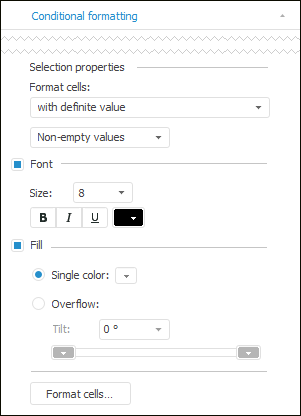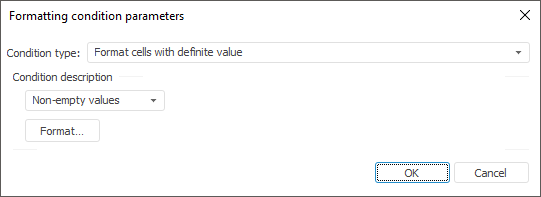
This formatting condition type is used to format cells with definite values.
For example, the cells that contain values above 65 are formatted:

To set up cell formatting with definite values, use the Conditional Formatting tab on the side panel or the Formatting Condition Parameters dialog box.


Determine the following settings:
Format Cells. Select the type of formatted values. The set of options depends on the selected type:
Value. Cells that contain numeric values satisfying the condition are formatted. Set comparison operator and value to compare, for example:
![]()
The cells with zero values are formatted.
Text. The cells with text values satisfying the condition are formatted. Set comparison operator and required text, for example:
![]()
The cells with the text "20" are formatted, for example, "1204", "201", "120", and so on.
Date. The cells with the date satisfying the condition are formatted. Set required date, for example:

The cells with the current date are formatted.
Empty Values. The cells with empty values are formatted.
Non-Empty Values. The cells with any values are formatted.
Font. Select the checkbox to determine font settings in the cells with formatted values. Set font size, style and color in cells in appropriate boxes.
Fill. Select the checkbox to determine fill settings in the cells with formatted values. Set fill type:
Single Color. Solid cell fill. Select fill color in the drop-down palette.
Overflow. Two-color gradient is used to fill cell background. Select the start and end colors of the gradient in the appropriate drop-down palettes. Use the Tilt box to set gradient tilt angle.
Format Cells. Click the button to set up additional formatting parameters for cells with definite values. The Formatting dialog box opens.
NOTE. The option is available only in the desktop application.
See also: